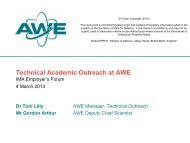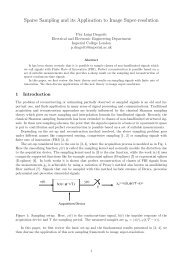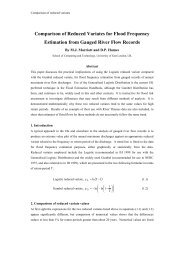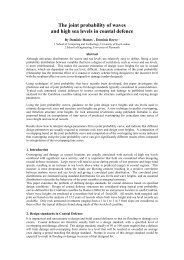IMANA NEWSLETTER - Institute of Mathematics and its Applications
IMANA NEWSLETTER - Institute of Mathematics and its Applications
IMANA NEWSLETTER - Institute of Mathematics and its Applications
Create successful ePaper yourself
Turn your PDF publications into a flip-book with our unique Google optimized e-Paper software.
18 11 PHD THESES<br />
News from NAG<br />
A.G.Ms are not normally described as ‘exciting’ but this year NAG’s Annual General Meeting<br />
excelled in this capacity with a mathematical talk from Peter Jimack, a fascinating recount <strong>of</strong> the early<br />
development <strong>of</strong> NAG from Brian Ford, a stimulating discussion on the payment <strong>of</strong> board members, the<br />
presentation <strong>of</strong> a life award to Steve Hague <strong>and</strong> a very close election to the NAG board.<br />
Pr<strong>of</strong>essor Peter Jimack, from the University <strong>of</strong> Leeds, is a newly co-opted member to the NAG board<br />
<strong>and</strong> his presentation introduced his academic work to the NAG membership. He discussed the solution<br />
<strong>of</strong> a system <strong>of</strong> highly nonlinear parabolic PDEs, for the simulation <strong>of</strong> the solidification a non-isothermal<br />
binary alloy. The challenges <strong>of</strong> this model included the need to resolve a moving feature (the solidliquid<br />
interface) at very small length scales, the existence <strong>of</strong> vastly different time scales (leading to severe<br />
stiffness) <strong>and</strong> the desire for simulations to be in three space dimensions. In order to develop efficient<br />
<strong>and</strong> reliable simulation s<strong>of</strong>tware he needed to incorporate mesh adaptivity (for locally enhanced spatial<br />
resolution), an implicit stiff integrator in time, <strong>and</strong> to use multi-grid methods to solve the resulting<br />
nonlinear algebraic system <strong>of</strong> equations at each time step. Extensions to three space dimensions required<br />
the use <strong>of</strong> parallel implementations on the high performance computing (HPC) facility at Leeds. His talk<br />
therefore satisfied the technical appetite <strong>of</strong> numerical mathematicians <strong>and</strong> <strong>of</strong> s<strong>of</strong>tware engineers.<br />
Brian’stalk described in graphicdetail the trials <strong>and</strong> tribulations <strong>of</strong> the first few years<strong>of</strong>NAG, illustrated<br />
by various ’props’, such as a magnetic tape <strong>and</strong> punched card used at that time. He described the<br />
enthusiasm <strong>of</strong> developers <strong>and</strong> users <strong>and</strong> the long hours spent in the machine rooms forming a library.<br />
He recounted the trip from Nottingham to Oxford to use the facilities there <strong>and</strong> how the local fish <strong>and</strong><br />
chip shop provided valuable nourishment as darkness fell. He spoke about the naming scheme adopted<br />
by NAG for <strong>its</strong> routines - the modified SHARE classification scheme by which NAG routines are still<br />
instantly recognised. Apparently the vote on this was very close; only vote decided the issue over a<br />
mnemonic naming scheme. However Brian felt that the decision had been correct. Of course now the<br />
Fortran language has removed a restriction <strong>of</strong> 6 characters for a subroutine name <strong>and</strong> so our new Mark 23<br />
Fortran library <strong>of</strong>fers a choice <strong>of</strong> the familiar short name <strong>and</strong> a more descriptive long name. For example<br />
users can call E04NXF or nagf opt qpconvex2 sparse option integer get to use the same routine.<br />
The business part <strong>of</strong> the A.G.M. led to a discussion on the payment <strong>of</strong> board members. The chairman<br />
outlined the proposals<strong>and</strong> gainedsupport fromDavidHartleywhopreferredto usethe term’honorarium’<br />
for such payments. Other members were less enthusiastic about the idea.<br />
The election to the board was contested by two c<strong>and</strong>idates: Bill Burke who had served as a co-opted<br />
member <strong>and</strong> John Reid, who had been a member <strong>of</strong> NAG for many years <strong>and</strong> had contributed to the<br />
library development throughout. The contrast in CVs was marked; Bill being on the commercial side<br />
<strong>and</strong> John on the technical. In the event the number <strong>of</strong> votes counted resulted in a tie, a perfect balance<br />
between commercial <strong>and</strong> technical, but not perhaps the outcome the NAG chairman would have wanted!<br />
Finally, I must end by congratulating my friend <strong>and</strong> colleague, Malcolm Cohen, for winning this year’s<br />
1906 Award from the International Electrotechnical Commission. The 1906 Award commemorates the<br />
IEC’s year <strong>of</strong> foundation <strong>and</strong> honours IEC experts from around the world whose work is fundamental to<br />
the IEC. Malcolm gained this honour for his work as Editor <strong>of</strong> the Fortran st<strong>and</strong>ard. He is, <strong>of</strong> course, a<br />
co-author <strong>of</strong> the book ’Modern Fortran Explained’, by Michael Metcalf, John Reid <strong>and</strong> Malcolm Cohen<br />
<strong>and</strong> is the driving force behind NAGs own Fortran compiler.<br />
David Sayers (David.Sayers@nag.co.uk)<br />
11 PhD Theses<br />
Ray Millward(Bath). A new adaptivemultiscale finite element method with applicationsto high contrast<br />
interface problems<br />
Fynn Scheben (Bath). Iterative Methods for Criticality Computations in Neutron Transport Theory.<br />
Maha Al-Ammari (Manchester). Analysis <strong>of</strong> Structured Polynomial Eigenvalue Problems.



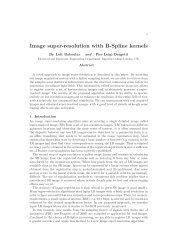

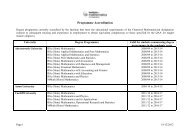
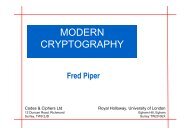
![Download NLAO Application Form [PDF] - Institute of Mathematics ...](https://img.yumpu.com/22617151/1/184x260/download-nlao-application-form-pdf-institute-of-mathematics-.jpg?quality=85)
![Download Education Grants Application Form [PDF] - Institute of ...](https://img.yumpu.com/22617149/1/184x260/download-education-grants-application-form-pdf-institute-of-.jpg?quality=85)
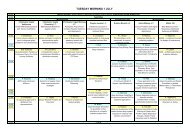
![IMA IPD brochure [PDF] - Institute of Mathematics and its Applications](https://img.yumpu.com/22617139/1/189x260/ima-ipd-brochure-pdf-institute-of-mathematics-and-its-applications.jpg?quality=85)
